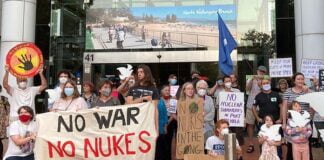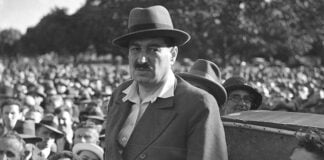As Australia became the test site for nuclear weapons in the 1950s, opposition developed through the unions and a new peace movement, writes Lucy Honan
The first nuclear bomb detonated at Maralinga in South Australia had as much explosive strength as the bomb the US dropped on Hiroshima. From 1952 to 1963 the Australian government welcomed the UK’s Atomic Weapons Researchers’ testing program, which poisoned people, land and water, rendering some places uninhabitable for a quarter of a million years.
But the weapons testing program met resistance even before it went nuclear. Despite the repressive and confusing fog of Cold War, the peace movement had success derailing much of the testing program in the 1960s.
As the Australian government looks to the same Aboriginal lands in the South Australian desert to dump nuclear waste from the AUKUS submarines, we can draw on the traditions this movement developed to pick up the fight for nuclear disarmament today.
Weapons frenzy
Britain emerged from the Second World War in a rearmament frenzy. Despite a war traumatised population, with infrastructure destroyed and bread rationing in place, the Atlee Labour government’s priority was spending any amount necessary to develop terrifying weapons to maintain its waning position as world power.
In 1946, the USA excluded Britain from its nuclear technology secrets, blaming British scientists for spy rings and leaks to Russia, and consolidating its own exceptional power.
The Australian Labor government had its own fantasies that hosting the development of Britain’s weapons would give Australia access to nuclear technology and potentially even nuclear weapons, conferring more power to throw around in the region. So Britain and Australia began their collaboration testing weapons in the Central Australian desert in 1946.
Working-class organisations were the first to respond, enraged by the obvious threat to Aboriginal people, the waste of resources and fears of yet another global war.
The South Australian Trades and Labour Council passed a resolution calling for abandonment of the program as did the Waterside Workers Federation, Building Workers Industrial Union, Hotel Club and Restaurant Employees, Sheet Metal Workers, Boiler Makers and NSW Nurses.
Labor Prime Minister Chifley admitted that there was plenty of opposition to the weapons program from within the Labor Party.
Unionists, Quakers, the Women’s Christian Temperance Union, the Howard Reform League, Aborigines “Friends” Societies, the Council of Churches, the Socialist League, the Federation of Scientific Workers, the Communist Party of Australia (CPA) and others came together to form campaign committees against the rocket range across the country.
Some 1300 attendees at the Melbourne Rocket Range Protest Committee meeting in March 1947 almost unanimously endorsed a call “to abandon the rocket project in the interests of the aborigines and world peace”.
Cold War
The CPA’s membership was in free fall after the war but it still had more than 12,000 members in 1947 who looked with hope to the rotten example of Stalin and the Soviet Union.
The CPA opposed the British testing program and any bombs designed to threaten Russia.
But it was also committed to the politics of “national self-defence” following the USSR’s example, so it supported Australia’s acquisition of weapons technology.
These twisted politics meant the CPA organised working class resistance into action, only to discredit and misdirect it.
Having urged its members to agitate against the testing program, unions where CPA members had influence began to declare bans on building the rocket range; in March 1947 the federal council of the Operative Painters and Decorators Union called on its branches to enforce a ban on Woomera (the site chosen for the testing base).
By early May the Victorian Building Trades Federation called for a total union ban on Woomera, and this was endorsed by the South Australian building unions.
But given the prevailing atmosphere of red-baiting, these unions were too easy to discredit as tools of the Soviet Union. The ACTU stomped on the proposal and the ALP and right-wing unions claimed the ban was imposed at the behest of the Soviet Union.
Isolated, the CPA’s central committee issued a statement that the party was not opposed to the defence of Australia and the Victorian state CPA conference now declared opposition to the ban.
Metal workers’ union leader and leading CPA member Tom Wright put the conservative position bluntly: “Left wing union leaders must support proper measures for the defence of Australia, including knowledge and possession of rocket weapons.”
This retreat into nationalism did not prevent the ALP government from rushing through the Approved Defence Projects Protection Bill in June 1947—a gag that made it illegal for people or organisations to critically comment on the nation’s defence policy.
Despite objections from the rocket range protest committees, civil liberties groups and the ACTU, the gag legislation was effective for a time at muting opposition to the testing program.
Labor went on to menace the left with its new spy agency ASIO. In 1951 the Liberals were elected. Menzies generated a hurricane of anti-communist hysteria and Labor underwent a paralysing anti-communist civil war of its own.
Politically compromised and subject to permanent hostility though it was, the CPA continued to carve out a space for anti-war activity.
In 1950, the Australian Peace Council (APC), the party’s next project, held a Peace Congress at the Exhibition Centre in Melbourne with thousands of attendees.
Retreating from direct critique of Australia’s testing program, it launched the Stockholm Appeal, initiated by Eastern Bloc communists, which called for a global ban on atomic weapons.
Activists went door to door with the petition, handed out placards and, when these were deemed illegal, wore aprons with Ban the Bomb slogans. Some 200,000 Australians signed the petition and 500 million people signed it worldwide before nuclear testing had begun in Australia.
Nuclear announcement
The APC lost credibility by defending Russian nuclear tests as a defensive response to testing in the West, and lost relevance when it failed to respond to Menzies’ announcement in February 1952 that Britain would test atomic weapons in Australia.
But the Women’s International League for Peace and Freedom (WILPF) was willing to confront the Australian ruling class squarely, and immediately called a public meeting which expressed “its emphatic disapproval of the use of the atomic bomb anywhere and particularly an atom bomb in Australia.”
Margaret Tucker, an Indigenous speaker at the protest meeting, said, “The government has said the tests won’t hurt a living thing, but my people are the last who would believe government promises.”
As the nuclear testing continued on the Montebello islands in Western Australia and in Emu Field and Maralinga in South Australia, public opposition built, from 52 per cent approving of Australia hosting the tests in 1952 to 58 per cent disapproving of them in 1956.
Peace congresses, conventions and conferences continued attracting thousands of participants.
A sense of personal danger informed public opinion as 9000 scientists across the world and 350 scientists in Australia called for a ban in view of “the threat facing humanity through the development of nuclear weapons”.
Government lies that “no Aboriginal people will be harmed” were exposed when the public saw footage of British service personnel discovering Anangu woman Edie Milpuddie and her family camped on the edge of the Marcoo bomb crater.
The family were roughly showered, their dogs were shot in front of them and then they were driven off to a mission in the south. Edie was pregnant and later lost her child.
A Western Australian investigation in the Warburton ranges exposed the brutal impact of land theft for weapons testing.
Activists screened films across the country showing the devastating malnutrition, exploitation, lack of hunting grounds, and inadequate water supplies, all caused by the loss of Aboriginal land at the Maralinga test ground and the associated Giles weather station.
Breaking open Labor
A breakthrough in the ALP and the unions came in 1958. The ACTU, trades and labour councils and unions became active in the anti-nuclear protests, supporting not just the call to “ban the bomb”, but also now calling to ban British bomb tests in Australia.
The ALP encouraged members to join national demonstrations against the British tests and the Victorian ALP journal, Tocsin, launched “Labor’s Atomic Week” of educational activities leading up to a protest.
The “New Left” emerged as many CPA members left the party in the wake of Russia’s invasion of Hungary in 1956.
More groups formed, like the UK-inspired Campaign for Nuclear Disarmament or CND, which called for unilateral disarmament rather than negotiations between the superpowers, putting the finger more firmly on our own government. They organised vibrant street protests and defiant stunts, and breathed new life into the anti-nuclear campaign.
The Cuban missile crisis in 1962, which saw the US and the Soviet Union confront each other over Russian nuclear missiles in Cuba, vindicated the movement, proving how close to nuclear destruction the two superpowers could bring the planet.
In the face of global opposition to the nuclear arms race and testing, Britain, the United States and the Soviet Union signed the Partial Nuclear Test Ban Treaty on 6 August 1963, banning all atmospheric testing.
This was effectively the end of the nuclear testing program at Maralinga, though the devastating contamination and effects of dispossession are as live as ever today.
Australia’s reckless investment in the AUKUS pact as part of a cold war-style arms race against China delivers us into tragically familiar terrain.
But the fight to end nuclear weapons testing at Maralinga shows that working class organisations have the power to fight our government’s nuclear ambitions to a standstill.

![John L Stanier [?sp] at Maralinga in protective clothing showin](https://solidarity.net.au/wp-content/uploads/2023/06/Maralinga.jpg)




